A defining aspect of the globalized 21st century, modern cities reflect the world around us, constructing a built environment within which the majority of humans live. Understanding their past, present, and future allows us to evaluate the impact they have on shaping our lives. While there are thousands of urban hubs across the world, some have such large populations that they fall into their own category of megacities. A megacity can be defined as a metropolis with more than 10 million inhabitants, for example, Tokyo, New York City, and London. There are a proportionally high number of megacities within the Asia Pacific region, especially in China. This led me to the initial question, why there? What about China, specifically the coast, has enabled the development of so many megacities? The history behind Chinese megacities can be traced back to some of the earliest settlements on the continent, which have developed over time into the sprawling hubs they are today, with intense urban growth occurring in the past hundred years. Following the industrialization of much of the western world during the 19th and 20th centuries, China experienced a simultaneous shift from rural to urban communities and a significant population boom during the mid-20th century. The Chinese government at the time developed an agenda to catch up to and build upon the globalized cities of Europe and the United States, looking to join the global sphere as a key player. In 1958, Chairman Mao and his communist party initiated the Great Leap Forward, his formal campaign to transition from an agrarian to industrial society. The government invested extensive resources in urban development, constructing new towns and cities designed for manufacturing and mining, in addition to self-sustaining working communes. They built an entirely new highway and high-speed train system throughout the country to connect the rural regions to the growing urban centers, enabling mobility and circulation. The Chinese people flooded into cities, searching for a better quality of life within the country’s reconstruction. In addition to infrastructure changes, Mao also designated Special Economic Zones throughout the country, cities where domestic and foreign trade could occur without government supervision, allowing rapid economic growth on a global level. Coastal port cities in particular played a key role in this new era of China, due to their strategic and convenient location for trade by sea. In 800 BCE, China had a population of 13.7 million, and by the beginning of the 21st century, it had grown to 1.3 billion. The population growth was to such an extent that in 1979, the Chinese government enacted the one-child policy to limit the increase. It was in effect until less than ten years ago, demonstrating the legacy of Mao’s regime. While ultimately deemed a failure due to the economic consequences, the Great Leap Forward was effective in helping China begin its transition into a global superpower. Now, almost seventy years later, China is home to a number of the world’s largest megacities.
With these massive urban centers comes many complex and interconnected issues. They are continuing to grow upwards, as architecture expands towards the sky, but not out–becoming more and more dense over time. There is a lack of available land for agriculture, and the city sprawl makes commuting from the countryside a prohibitive obstacle to having an effective urban-rural dynamic. Climate change poses a dangerous threat to humanity, and China is at the forefront of environmentally problematic nations due to its high levels of natural resource consumption and emission outputs. This reality led me to the next phase of my research, in which I seek to understand the functionality of megacities and how they can be made more sustainable. How can Chinese megacities be evaluated and improved upon in the context of the environmental crisis of the 21st century? City planners and architects have engaged with a wide range of intervention strategies, ranging from compact design to walkable communities to ‘smart city’ technology (electronic data collection, e.g.). A pioneering experiment occurred with the eco-city of Tianjin, co-sponsored by the Chinese and Singaporian governments. The vision for Tianjin was to leverage limited resources in a non-arable region to develop a sustainable urban village that could be used as a replicable model for other Chinese cities. Construction began in 2008, and Tianjin now has a population of over 100,000. The project has been considered a success thus far and will continue to be improved upon in the coming years. The eco-city framework serves as an example of an effective urban development intervention, demonstrating the potential for other Chinese cities.
After researching the implications of sustainable design, I next looked at the human response to megacities. Living in densely populated, polluted, postmodern urban settings can negatively impact humans and their health. The day-to-day experience of individuals within the built environment reflects the effectiveness and structure of the environment’s formation. The human rights impacts of urbanization are also intricately woven with social justice in contemporary China. Turning to the Chinese art world was the natural continuation, as art is a powerful medium for self-expression and cultural commentary. The most recent component of my research question developed into the following: how have Chinese artists reflected on the existence of megacities through their work? My analysis of the images below aims to visually deconstruct the artists’ intention, framing the human experience of megacities within contemporary Chinese art and offering critiques on the societal conditions that have developed through rapid urbanization. The layered nature of my research has permitted development in critical thinking throughout the process, establishing a thorough contextual understanding of Chinese megacities.


Crying Landscape is a series of five ink triptychs, depicting a variety of scenes of landscape destruction. They emulate the traditional Chinese blue and green ‘shan-shui’ painting technique, which dates back to the Tang Dynasty. The content of the pieces focus on political and industrial power–key features of megacities–showing iconic locations such as the Pentagon, the Houses of Parliament, and juxtaposing them with large-scale environmental disruptors such as the Yangzi Gorge dam and an oil refinery. The large scale of the works and their overhead hanging display in the Metropolitan Museum of Art (no longer on exhibition) dwarf the viewer, creating an inescapable view of the 21st century environment. The title Crying Landscape references the suffering of the natural world at the hands of mankind. The artist of Crying Landscape, Yang Jiechang, grew up in China during Mao’s regime and the Cultural Revolution. With firsthand experiences of the failed sociopolitical movement, Jiechang criticizes the Maoist government’s utopian vision and its long-term fallout. Crying Landscape can be considered an effective response to the development of megacities because it draws a connection between cultural contexts and the built environment. The use of landmarks across the world also challenges the viewer to move beyond the sphere of Chinese cities, applying the same rhetoric of rapid industrialization and environmental damage from a global perspective.
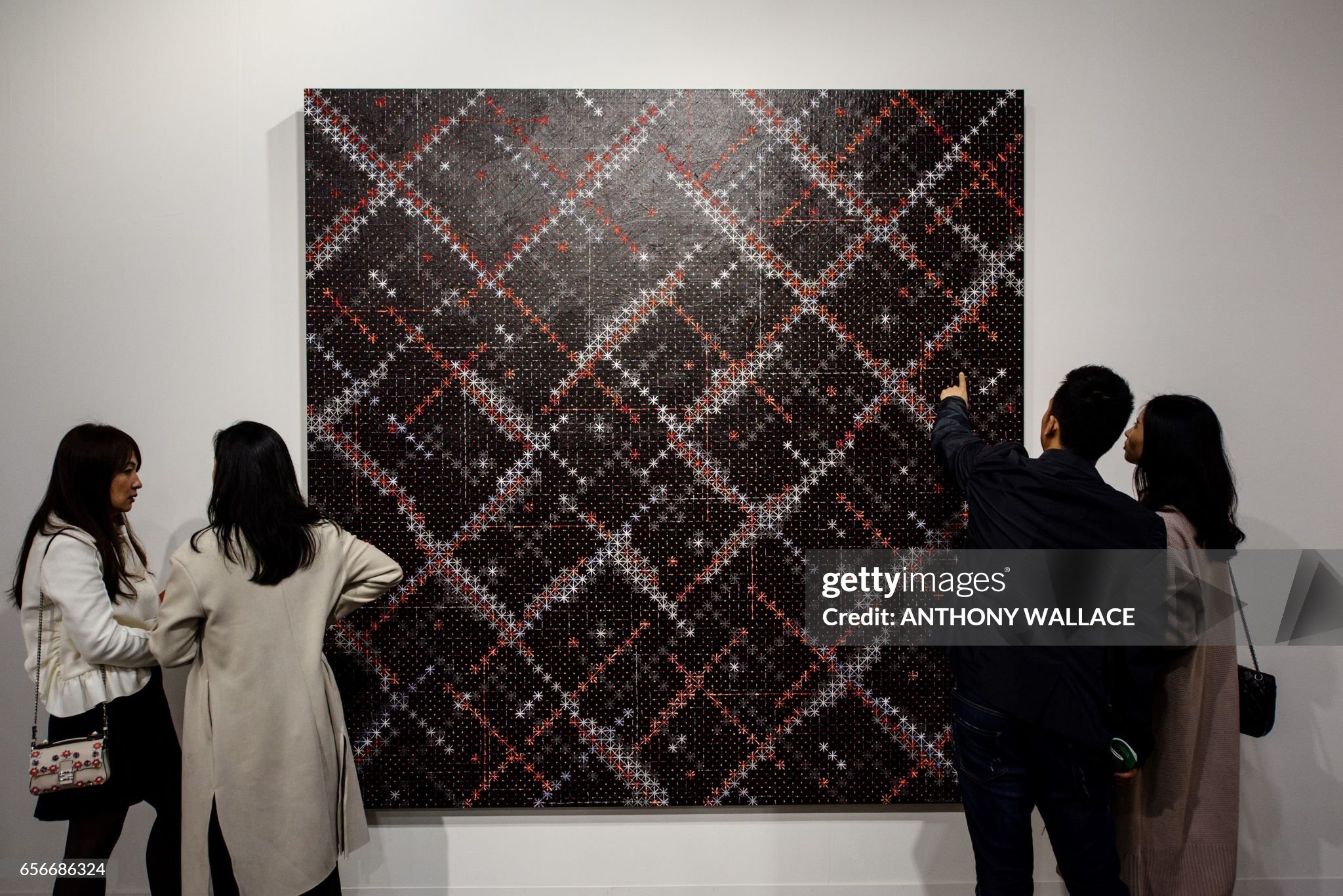
Appearance of Crosses 2016-12 by Ding Yi looks at the megacity through a more conceptual lens, adding to the artist’s portfolio of geometric-inspired pieces. In his work, Yi uses the recurring cross symbols ✕ and 🞡 as the basis for the visual structure, playing with scale and spacing to create intricate, complex compositions. Appearance of Crosses 2016-12 is intended to represent a zoomed-out aerial perspective of a city, showing diffracted light and axes as if looking down from a plane. Specifically, the use of red and white on a black background emulates the fluorescent glow of car headlights, putting an emphasis on traffic patterns (an indicator of the city layout) and transportation. The cross symbol can also be extrapolated to analyze urban design as a whole, referencing the gridded system of many cities, which dates back thousands of years. Similarly to Jiechang (see above), Yi grew up during the Cultural Revolution, demonstrating a consistent thread of the generation’s commentary on industrialization. This piece provides a more neutral view of megacities, abstracting their appearance into what is, without context, not an immediately recognizable commentary on the urban landscape. It requires the background knowledge of the artist’s origins to fully appreciate Appearance of Crosses 2016-12, incorporating the value of personal experience and identity.

The Whose Utopia series continues with the thread of the individual, critically examining the human implications of mass production required for industrialization. In a short film, female artist Cao Fei videos factory workers at the OSRAM lightbulb production facility in China’s Pearl River Delta region. They move and dance through the factory space, contradicting the strict control over movement established by mass production, where every item undergoes the same steps to create the same standardized outcome. In an attempt to humanize these workers, Cao Fei left it up to them to decide how they wanted to dress and perform, pushing back against the suppression of workers rights seen commonly in factories. In this particular image, My Future is Not a Dream 03, the person’s fluid movement creates a break in the repetitive, straight lines of lights and machines, immediately drawing the viewer’s eye to them. The shot employs interesting perspective work and depth of field, with both horizontal and vertical planes that extend beyond the frame and the man standing at their intersection. The Whose Utopia series brings art of the megacity into a social justice framework, creating a dialogue with the people who literally construct the cities. The medium also brings the art out of an enclosed gallery space, giving it a more authentic context as it responds to its setting.

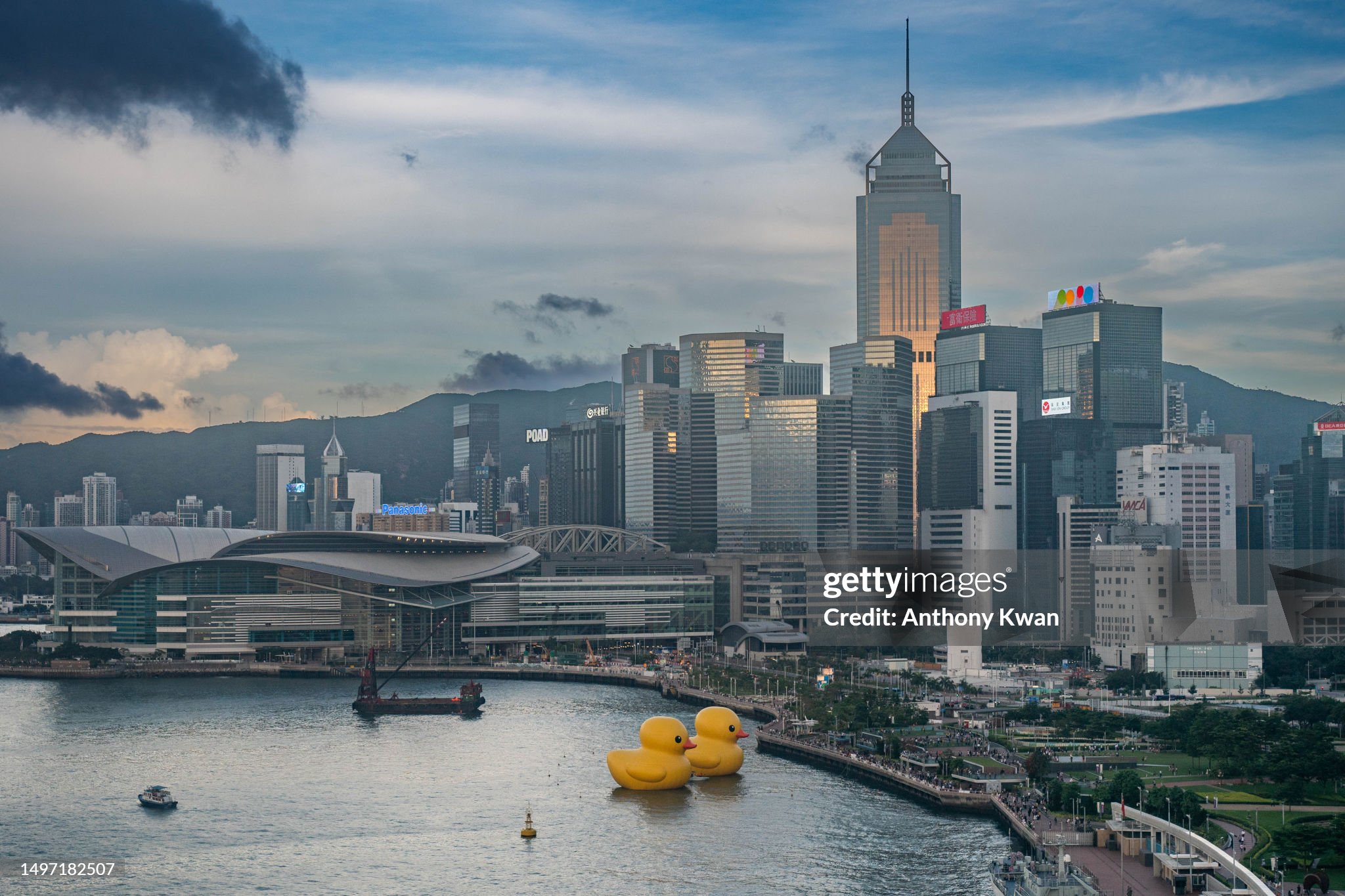
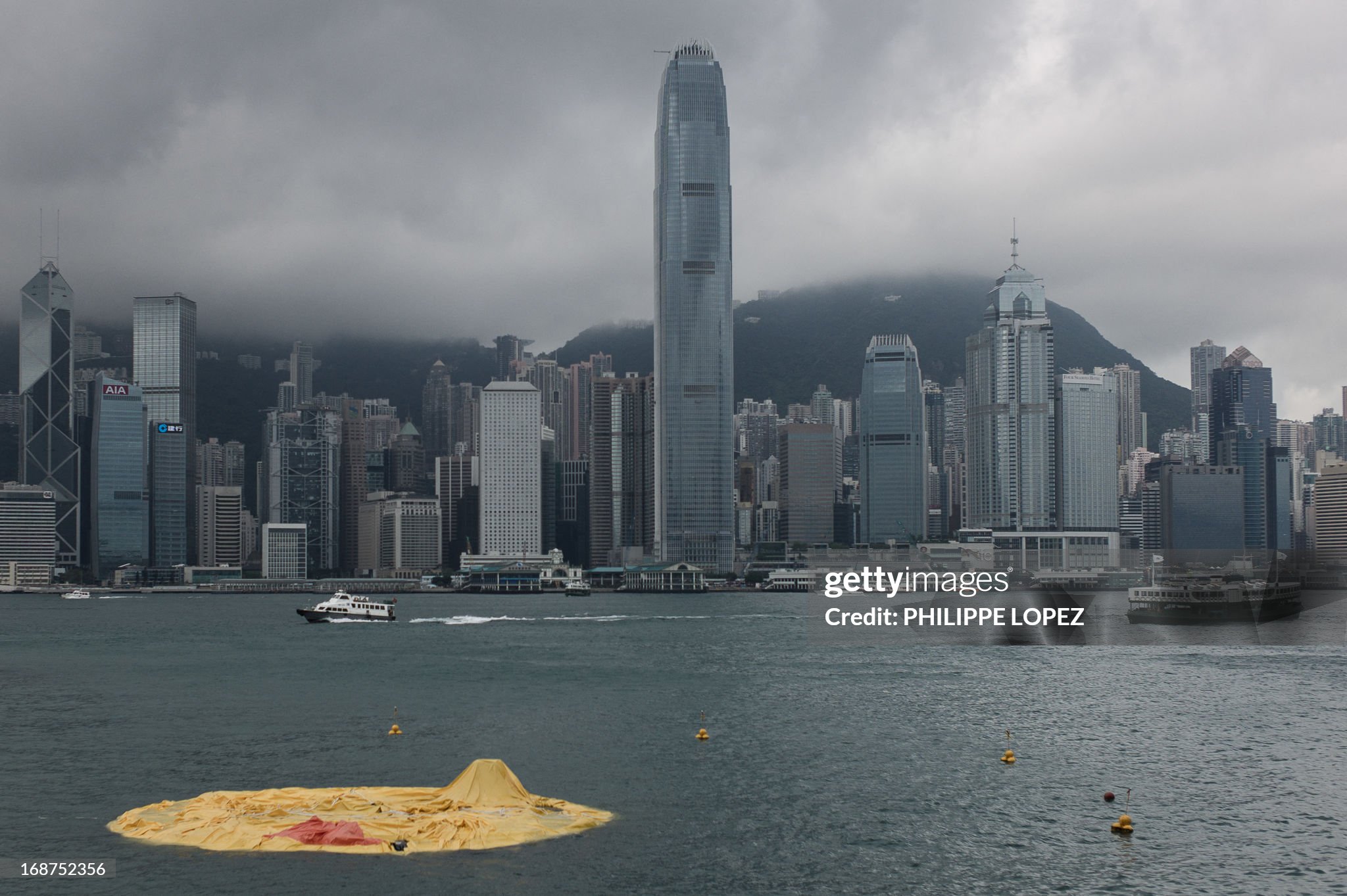
DUCKS, Florentijn Hofman, sculpture (PVC rubber), 18 m, 2013, Contemporary Chinese, Hong Kong Victoria Harbor, Getty Images
The Ducks and Double Ducks installations build upon the theme of art that interacts with its surroundings, as two public works that reflect global commercialism in the urban sphere. The first China-based iteration of the project was installed in Hong Kong in 2013. It was an incredibly popular attraction, however, it deflated and was removed within just a few weeks of its arrival. Celebrating the ten year anniversary of the project, a pair of the inflatable ducks returned to Hong Kong in 2023. Responding to the crisis of the 2020 global pandemic, the artist hopes to brighten the cityscape and bring joy to its residents. The addition of a second duck reflects the Chinese adage “good things come in pairs,” which finds its roots in the Daoist values of balance and harmony. It also connects to the visual form of Chinese calligraphy–the highest form of art in China–and the double happiness character. Double Ducks incorporate the concept of pairs to more effectively interact with their setting. The artist, Florentjin Hofman, is Dutch, and has completed similar works in megacities across the world. As the only non-Chinese artist whose work is analyzed in this series, Hofman breaks the pattern of creators with nearly identical backgrounds. Including his work brings a fresh perspective to the narrative, diversifying and broadening the commentary on Chinese megacities while still considering their unique cultural history. The massive size of the rubber ducks scales down the city, transforming Victoria Harbor into their bathwater within the tub of Hong Kong. The lightheartedness and color of Hofman’s installation contrasts the rigid urban forms and industrial materials. Furthermore, as a pervasive example of commercialism, the rubber duck responds to the inevitable decomposition of the city and its material form, represented in the image of the deflated yellow object. The artists’ public-facing vision uses the city of Hong Kong as a canvas, reinterpreting its role as hub of production and consumption.
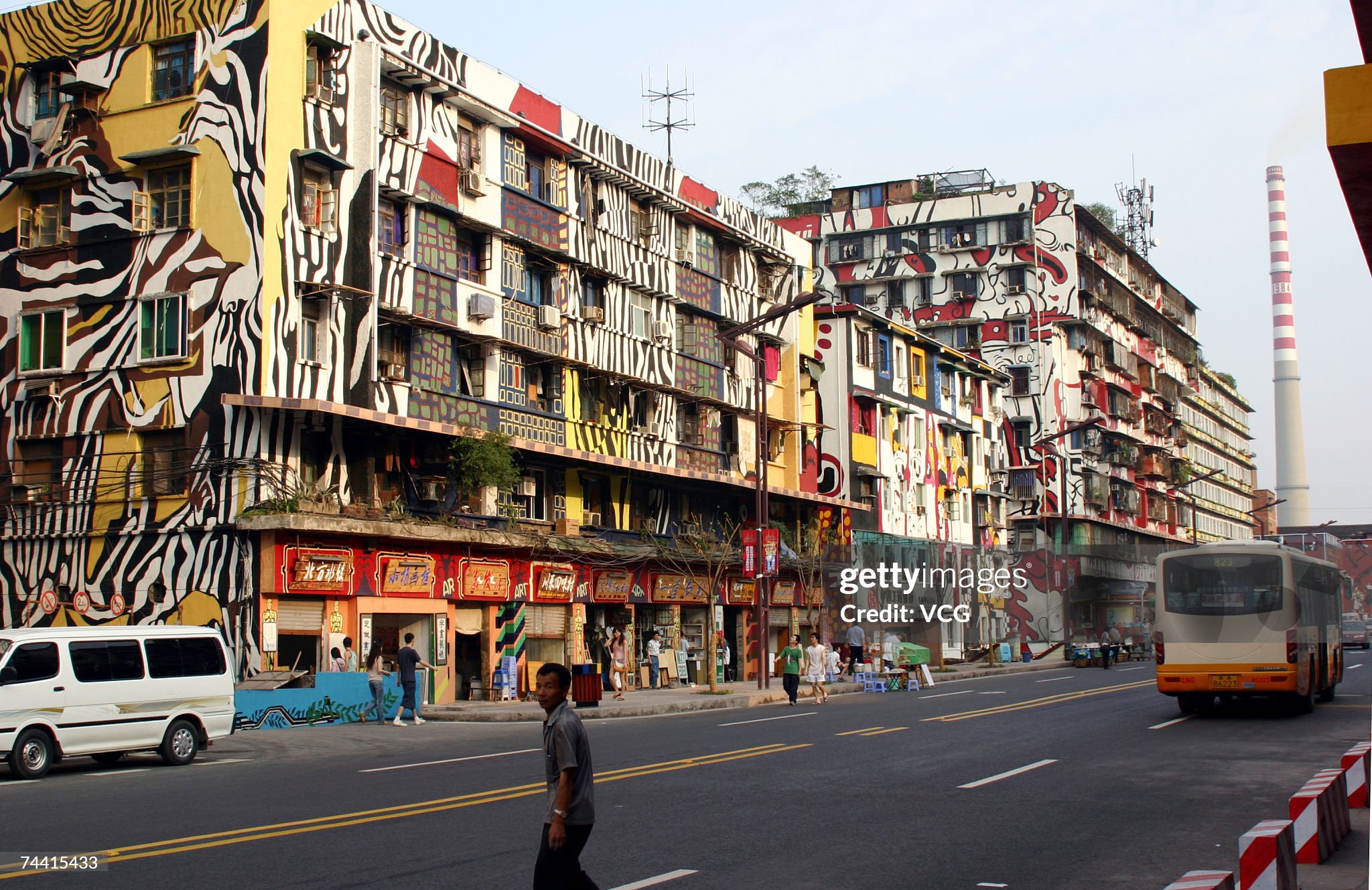
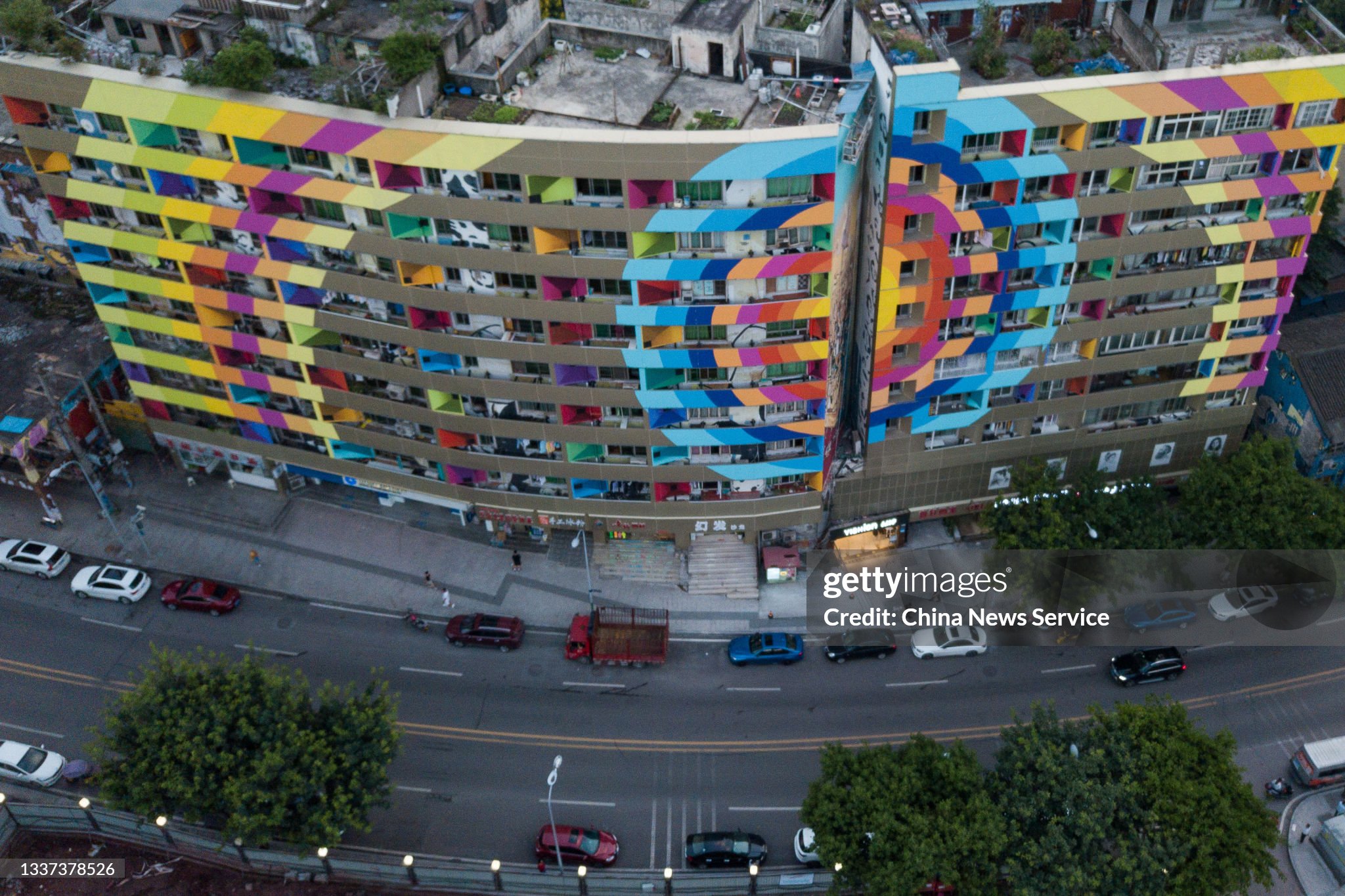
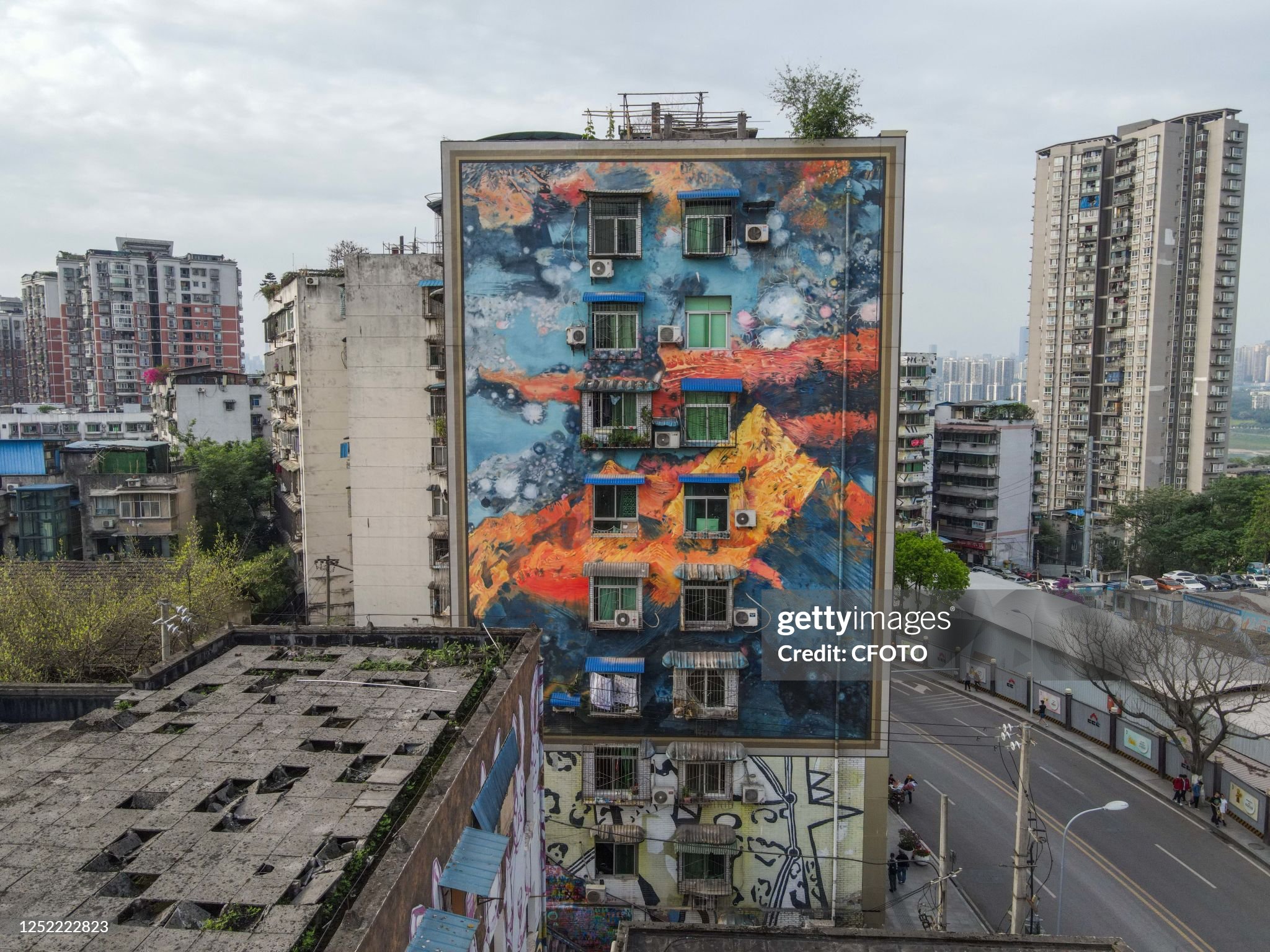
The Hunagjiaoping Graffiti Street is the largest public graffiti installation in the world, stretching for 1.25 kilometers. It took almost half a year to complete, and includes work by over 800 students, teachers, and community members. The project was developed by Luo Zhongli, who serves as the president of the Sichuan Fine Arts Institute in the same neighborhood of southwest Chongqing. While megacities often suppress the identity of the humans living within them, the Graffiti Street works against this notion, instead representing the mark of the people on the city. It is intended to showcase the spirit of the community and bring the urban landscape to life. In order to accommodate the project, buildings had to be demolished, pipelines redone, and the streets widened, demonstrating the unusual practice of making infrastructure changes to accommodate art. The Graffiti Street builds on the concept of the city as a canvas even more literally than the Double Ducks installation, as the imagery is painted directly onto the architecture. Representing a more positive take on modern megacities, this piece adapts the existing city to shape it to better suit the needs of its residents, a type of direct community action that has been incredibly well-received.
Beyond the scope of art pieces themselves, there are also scholars examining questions similar to the ones I have proposed through my research. In the academic journal China Perspectives, experts discuss the politics, society, culture, and economy of modern China. It aims to create an intellectual platform for discussing contemporary issues. The first component of my research, examining the development of Chinese megacities, can be supported by an article in the 2014 edition of China Perspectives titled “Chinese Urban Planning: Environmentalising a Hyper-Functionalist Machine?”. This piece considers the paradox of a rapidly industrialized country succeeding on a global economic scale with a government who claims to be committed to environmentalism. It seeks to understand why sustainability strategies aren’t being implemented to a satisfactory degree, and raises the question of whether urban development has gone too far. Next addressing my question surrounding environmentally friendly interventions, I included the article, “Can a Sustainable Urban Development Model Be Exported?: Construction of the ‘Exemplary’ Tianjin Eco-City.” This article looks at examples of eco-city models and questions whether they can successfully be applied to cities with different conditions. Specifically focusing on the city of Tianjin (discussed at the beginning of this post), the authors consider how urban design strategies change across locations and cultures. Finally, coming from a different source, I am leveraging the article “The Influence of Public Art in Developing Chinese Urban Public Space: Current Trends and Future Directions” to examine the artistic response to megacity growth. It is found in the book Cities’ Identities Through Architecture and Arts, which contrasts the previous journal. Instead of focusing on all things China, this book narrows its scope to architecture, while referencing examples from around the world. The chapter explores methods for creating a more authentic urban identity in Chinese cities, specifically analyzing trends within public art installations and how they assist in cultural diversity. It aims to evaluate how public art can be further integrated into the future of these cities. When looked at in conjunction, these three supplementary pieces of literature follow the narrative of my research and form an academic framework for the images shown above.
The multifaceted nature of megacities necessitates a holistic analysis, incorporating the sociopolitical and economic conditions that led to their existence. Chairman Mao and his Great Leap Forward spurred population growth and mass movement into Chinese cities, particularly on the coast with port access. New urban infrastructure and technological innovations promoted industrialization across China, with high-speed railways enabling the transport of people and goods. Spurred through the creation of Special Economic Zones, China joined the global market and broke through as a leader in production in the early 21st century. These factors enabled the development of cities with more than 10 million inhabitants, creating unique environmental circumstances that urban planners today aim to address through architectural and sustainability strategies. An investigation into the human impacts of megacities reveals how the Chinese population has been shaped by the urban landscape and vice versa. Looking at the five pieces shown above in conjunction allows us to track contemporary social commentary surrounding megacities. These case studies can be categorized according to typological threads including artist identity, attitude towards urbanization, and medium and scale of work. All except for Image 4 are created by Chinese individuals growing up during Mao’s regime, demonstrating a commonality of cultural experiences that shape their work. Including a piece by a Dutch artist broadens the global perspective and connects Chinese megacities to similar urban centers worldwide. The pieces demonstrate a range of perspectives, with the first image most heavily critiquing industrialization and megacities by showing the destruction they cause, and the last image working with the cities to improve the experience of living in them. In this way, the body of work I have compiled ultimately paints Chinese megacities in neither a purely positive or negative light, instead showing the extensive spectrum of responses to the environmental conditions they create. Finally, moving through the selections in the designated order follows a structure beginning within the confines of four walls, moving into the industrial space itself, and finally transforming the city into its own canvas. This progression seeks to push the boundaries of what is considered an artistic intervention and explore the interaction between the artist and their subject. Developing the project over a period of months has enabled me to push my inquiry further and incorporate later course material into my analysis.
Ultimately, the trends of growing urban hubs across China and beyond reflects 21st-century values of industrial production, globalization, and consumerism. The existence of the megacity both centers humans in their prioritization of money and power over protecting natural resources, yet also pushes them to the side as the one percent thrives off urban development at the expense of the less fortunate. Because postmodern urbanity is an inherently human issue, it requires a dialogue with the individuals involved to truly understand and improve upon the conditions. Moving forward, only time will tell how humans across the globe face inevitably continued metropolitan expansion. Most importantly, a conversation has been started, and efforts to keep this dialogue going will protect the human identity within the urban landscape.
Works Cited
“Cao Fei. Whose Utopia. 2006.” MoMA, 2020, www.moma.org/collection/works/399823.
Cheng, Han, and Julian Worrall. “The Influence of Public Art in Developing Chinese Urban Public Space: Current Trends and Future Directions.” Advances in Science, Technology and Innovation, Springer International Publishing, 2021, pp. 157–65.
Chen, H.Y., et al. “Sustainable Urban Form for Chinese Compact Cities: Challenges of a Rapid Urbanized Economy.” Science Direct, Pergamon, 4 Sept. 2007, www.sciencedirect.com/science/article/pii/S0197397507000367?via%3Dihub#aep-section-id12.
“China – Urbanization, Megacities, Population.” Encyclopædia Britannica, Encyclopædia Britannica, inc., www.britannica.com/place/China/Urban-areas.
Curien, Rémi, and Will Thornely. “Chinese Urban Planning: Environmentalising a Hyper-Functionalist Machine?” China Perspectives, no. 3 (99) (2014): 23–31.
Li, Yinghao, Céline Bonhomme, José-Frédéric Deroubaix, and Jonathan Hall. “Can a Sustainable Urban Development Model Be Exported?: Construction of the ‘Exemplary’ Tianjin Eco-City.” China Perspectives, no. 1-2 (113) (2018): 87–98.
Stauffer, Nancy. “Transportation Policymaking in Chinese Cities.” MIT News, Massachusetts Institute of Technology Energy Initiative, 21 May 2020, news.mit.edu/2020/transportation-policymaking-chinese-cities-0521.